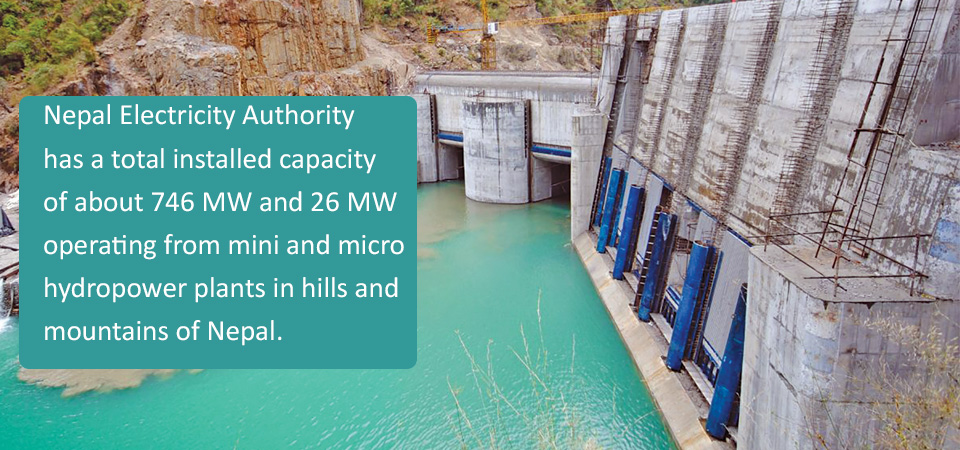Hydropower Development in Nepal

Shrija Dhakal
Hydropower is one of the renewable sources of energy in the world. It is achieved by converting the kinetic energy of water into electrical or mechanical energy. 16.6% of the total electricity production in the world is served by hydropower. Similarly, Nepal has been blessed with high potential of water resources, possessed with 2.7% of the world's fresh water resources.
Nepal is the second country after Brazil with more water reserves. Hydropower is the main source of energy in context of Nepal, nearly 90% installed capacity and about 90% generation of electricity. Thus, hydropower is an eco friendly source of energy with no pollution emitting in air or in land, and it also the most effective method to all.
Water Power
Now, while talking about history, the availability of water power has long been closely associated with jump-starting economic growth. When Richard Arkwright arranged Cromford Mill in England’s Derwent valley in 1771 to spin cotton and set up one of the world’s first factory systems, hydropower was the energy source he used there. The world's first hydroelectric power project was developed at Cragside in Northumberland in 1878, England by William Armstrong.
Likewise, in the context of Nepal hydropower development initiated on May 22, 1911 i.e. (9 Jestha 1968 BS) by installing 500 kW electricity at Pharping named as Chandra Jyoti. After a long duration of 25 years, Prime Minister Dev Shamsher initiated 640 kW, Sundarijal Hydropower plant with the capacity of 900 kW in 1936.
Sundarijal hydroelectricity development was once again stopped for decades. Again Morang Hydropower Company, established in 1939, built 677 KW Sikarbas Hydropower plant at Chisang Khola in 1942 though this Plant was fully destroyed by landslide in the 1960s. Nepal Electricity Corporation (NEC) was established in 1962 and was given the responsibility of transmission and distribution of the electricity in Nepal.
After a long gap, the hydropower generation capacity of the country prolonged with the construction of the Panauti Hydropower plant (2400 KW) in 1965 and the Trishuli Hydropower plant (24000 KW) in 1967. Recently the biggest hydropower of our country, 'Upper Tamakoshi Hydropower Project' of 456MW is in the final stage and all units are already tested and passed.
Also, its single unit of 76MW is already connected to the INPS. Before the Upper Tamakoshi Hydropower Plant, Kaligandaki A Hydropower Plant of 144MW was the biggest hydropower plant in the country. Nepal Electricity Authority was created on August 16, 1985 (Bhadra 1, 2042) under the NEA Act, through the merger of the Department of Electricity of Ministry of Water Resources, Nepal Electricity Corporation and associated Development Boards.
Ever since the NEA was established, it has been responsible for the generation, transmission and distribution of electricity. It currently operates two fuel operated plants generating 53 Megawatts of Electricity. The total capacity of the Integrated Nepal Power System (INPS), which NEA operates, stands at 1095 Megawatts.
Nepal's Potential
As we know, hydropower has a large potential in the context of Nepal. The country's appraised hydropower potential is to be upwards of 50,000 MW - actual electricity generation from hydropower in Nepal is currently 800 MW from 20 major hydropower plants and numbers of small and micro hydropower plants. Altogether, 6000 river counting rivulets and tributaries are present in Nepal.
In this way, it offers a great potential for hydropower development in Nepal while storage capacity is of 202,000 million m^3. The hydropower system is influenced by run-of-river systems in Nepal while storage scheme have been benefited to control flood, provide irrigation facility, drinking water supply, navigation, recreation, tourism, aquaculture, food security, health security, energy security, preserving the environment and generate bunce. Nepal can generate bunce of up to Rs. 310 billion per year in 2030 and as high as Rs1,069 billion per year in 2045 if the country is able to sell electricity to India mobilise its hydropower potential.
Nepal Electricity Authority has a total installed capacity of about 746 MW and 26 MW operating from mini and micro hydropower plants in hills and mountains of Nepal. This way Nepal has huge scope in the sector of hydropower development.
Challenges
Though Nepal it has one of the highest per capita hydropower potentials in the world, it is still back to tapping rich hydro resources. Through the development of hydropower, a lot of befitting discernment in regard to national economic enhancement could be attained but there a lot of technical and financial challenges which the hydropower developers could pass through which has been vividly articulated as below:
Nepal is a natural hydro resource rich country yet starving for economic prosperity through hydropower development. Many technical challenges had to be borne up with for hydropower development. Some of them are: fragile geology, hydrologic vriability, elevated sedimentation, geopolitical situation and topographical restrictions, harsh environmental concerns and a lack of policy involvement regarding hydropower development.
Another challenge is financials. Hydropower financing can be very challenging. While it is a low-cost source of power with low functional costs, it is capital intensive, meaning that a huge or big deal of investment takes place. Some of them are listed below:
-Major restrictions in mobilising funding from financial intermediaries (FIS)
Market failure and portfolio mismatch in financial intermediaries (FIS)
Lack of project finance instrument
Lack of 'due diligence' capacity in FIS
Central Bank Guidelines insensate to Power Sector
Foreign Exchange Risk
Repatriation risk
Construction risk (time and cost overturn)
Local level disputation and risk
Prospects
Hydropower can play a vital or major role in addressing increasing demand worldwide for clean, reliable, and affordable energy. In the present scenario, 733 MW out of 782 MW installed capacity is hydropower. All over 478 MW of hydropower capacity is NEA-owned, while 255 MW is privately owned and manipulated. However, the installed capacity is 1,128.69 MW as of 2019 data, and over 20 % of Nepalese remain deprived of grid electricity. The current peak load of electricity demand is 1,320 MW, while annual energy demand has increased by 9% and expected to increase to 2,379 MW by 2022 and 4,280 MW by 2030.
This increase in the production of hydroelectricity will not only attain the demand of the country but also the excess electricity that can be exported and improve our trade loss for the country. To get this, Nepal has to overcome the different challenges by joint efforts from government, other private sectors and financial sectors.
Changing Scenario
Nepal is gifted with huge hydropower potential. Although being a landlocked country with no known fossil fuel resources signifies the importance of water resources here. Despite some recent successful labour to use these vast water resources for its development, Nepal it has not been able to use this enormous resource fully for its economic growth. It is weird that the country has an underperforming power sector with supply shortages, reliability issues, and poor access to electricity, while sitting on an enormous potential to produce hydropower.
Adequate supply of power with suitable quality is a prerequisite for any nation to modernise its economy and to sustain economic growth. Nepal’s electric power sector has been trapped in low-level investment stability, and the only path to exit from this is an injection of public, domestic, private, and external agency investment in hydropower development. The situation has changed since 2016, but more strenuous efforts through public intervention are needed to overcome barriers to develop hydropower resources in the country.
(Dhakal is a Bachelor's student at
Geomatics Engineering, Kathmandu
University. shrijadhakal@gmail.com)
Recent News

Do not make expressions casting dout on election: EC
14 Apr, 2022
CM Bhatta says may New Year 2079 BS inspire positive thinking
14 Apr, 2022
Three new cases, 44 recoveries in 24 hours
14 Apr, 2022
689 climbers of 84 teams so far acquire permits for climbing various peaks this spring season
14 Apr, 2022
How the rising cost of living crisis is impacting Nepal
14 Apr, 2022
US military confirms an interstellar meteor collided with Earth
14 Apr, 2022
Valneva Covid vaccine approved for use in UK
14 Apr, 2022
Chair Prachanda highlights need of unity among Maoist, Communist forces
14 Apr, 2022
Ranbir Kapoor and Alia Bhatt: Bollywood toasts star couple on wedding
14 Apr, 2022
President Bhandari confers decorations (Photo Feature)
14 Apr, 2022


